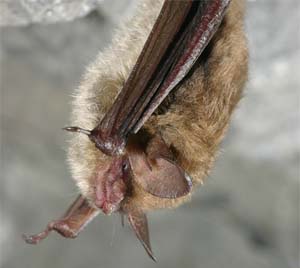(703) 881-3170
Virginia Bat Information
Northern Long-eared Bat

The Northern Long-eared Bat is listed as Endangered by the State of Virginia and by the US Government. The main threat to this species is a disease called White-nose syndrome. This disease attacks bats when they hibernate and will make them active during hibernation, making them lose their fat reserves and killing them. Other factors are human involvement, most notable people going into their caves during hibernation and disturbing them like how white-nose syndrome does. This bat can appear in attics of homes during the summer months as temporary roosting areas. Our exclusion program will make sure that they do not come back without harming or disturbing this species as it is protected by the state of Virginia. The Northern Long-eared bat is migratory, and can be found all throughout Virginia, but retreats into the mountains in caves during the late fall and early spring. During the summer these bats can be found in small crevices in groups. We tend to find them in attic vents or in the soffits of homes.
Northern Long-eared Bat Characteristics
Compared to other bats of the Myotis genus (Mouse Eared Bats) the Northern Long-eared bat has much larger pointed ears, which is where it gets its name. This bat is usually around 3.4 inches in size, with a 1-inch long tail. This makes this bat have a larger wingspan and tail than other bats in the Myotis genus. This bat has light brown colored wings with dark shoulders.
Northern Long-eared Bat Mating and Breeding
The mating habits of the Northern Long-eared bat have not been extensively studied in Virginia. However, it is assumed that mating takes place in the fall and has delayed fertilization. Leads to birth in the spring after hibernation. These bats tend to mate outside of the caves, on tree barks, barns, and other buildings.
Northern Long-eared Bat Diet
Instead of hunting insects in the air like other bats, the Northern Long-eared bat partakes in gleaning. Which is where they take food from leaves, twigs, and the ground. They primarily feast on moths, flies, beetles, and spiders.
